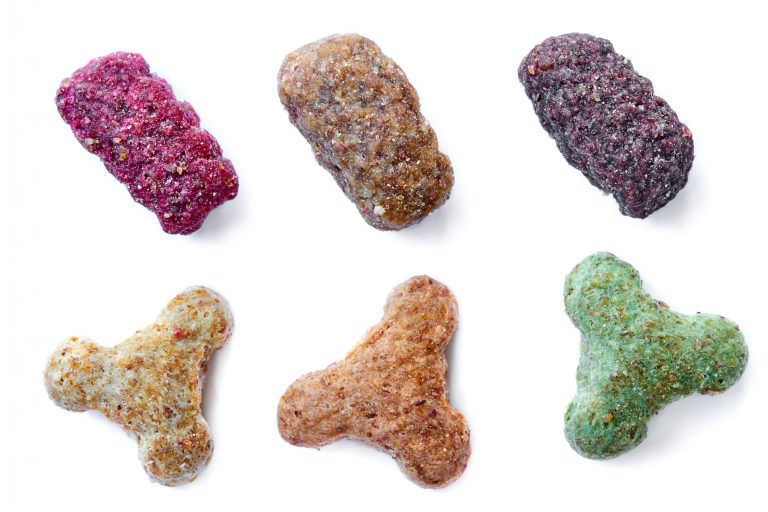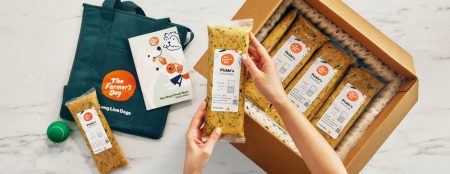When it comes to food, there are two kinds of crunch. One is the naturally occurring crisp snap of a fresh apple or raw carrot. The other is the brittle crunch of processed food like potato chips or cookies. Only one of these forms of food we consider to be health food.
And yet, when it comes to dog food, there’s an enduring assumption that crunchy, processed kibble is healthy for our canine companions to eat at every meal. But, like kibble itself, when you apply any pressure to this idea, it shatters into a million little pieces.
Let’s take a hard look at this hard food, and serve up some equally hard facts about crunchy kibble and what that sound means for the health of dogs.
Crunch = high heat manufacturing processes
When you hear that kibble crunch, what you’re hearing is the sound of a high-heat manufacturing process that was invented a long time ago, for our convenience. The process used to get that crunch is the opposite of healthy; it turns feed-grade ingredients into dried pellets, reducing whatever nutrients those ingredients may have had.
Here’s an extremely condensed version of how kibble is made:
First, the ingredients: Kibble is typically made from protein, fat, grains and a mix of vitamins. The protein often includes leftovers from the process of making human food. But due to certain regulatory loopholes, other stuff can end up in there as well, including but not limited to so-called 4D meats (diseased, disabled, dying, and dead animals—which includes euthanized animals). Commercial pet food ingredients only have to meet the standard of animal “feed”—which allows for the inclusion of things that are not allowed in human food. These ingredients can make their way into pet food via a high-heat process called “rendering” that blasts them to kill pathogens, and separate solids from moisture, producing the powdered substance you see on pet food labels called “meal.” Meal and other ingredients have to be mixed with starches, like potatoes, rice, soybean meal, corn meal, cracked wheat, and barley, and combinations of those things, which act like a glue to bind the ingredients together into a dough (So, yes, kibble is a dough-based food, just like those cookies).
The dough is heated (another application of high heat) before proceeding into the extruder, a machine that’s like a big pasta maker. The dough is extruded, or forced through specially cut dies, under high heat and pressure, and cut into the small, uniform shapes you know as kibble. This is the same process that’s used to make crunchy breakfast cereals, and cheese puffs.
Because kibble is designed to sit in bags on shelves and in pantries for long periods of time, the manufacturing process also includes high-heat drying to reduce moisture even further, and can include the addition of preservatives.
Finally, because this lengthy, desiccating process reduces nutritional value and flavor, palatants (fats that make the food taste like something to dogs) and vitamins are sprayed on the finished product.
Ta-da! You’ve got crunchy kibble.
Crunch = less digestible
The ingredients in kibble sound gross, but it’s more than just the “ick factor” that makes them less desirable as dog food components—they don’t provide as much nutritional value to your dog as clean, whole meats. But even if pet food companies used better ingredients in their food — as some claim to — the process used to make dried balls of kibble reduces the food’s nutritional value.
Studies have shown that the extrusion process reduces food’s bioavailability, the degree to which nutrients in food can be used by the body. As one study concluded, “undesirable effects of extrusion include reduction of protein quality,” decrease in palatability, and loss of vitamins.
Crunch = super dry
It’s easy to overlook the importance of hydration to your dog’s health. Keeping your dog hydrated is important to a range of bodily functions including digestion and kidney health. Hydration is provided by fresh water, but your dog’s food should also be providing moisture to your dog’s body, not removing it. Unsurprisingly, because kibble is dehydrated, it can have a dehydrating effect on your dog.
Crunch ≠ clean teeth
Here’s an old chestnut that deserves to be buried for good: all crunchy kibble helps keep dogs’ teeth clean.
While there are varieties of dental kibble designed to help with dental health, typical kibble does no such thing.
According to VCA Animal Hospitals, more than 80% of pets older than three years of age have active dental disease.
The myth that you need kibble to clean teeth rests on the idea that the crunch of kibble performs some sort of scraping function that helps clean teeth. But if you think about what happens when you eat crunchy cookies, the premise doesn’t hold up.
“It’s folklore,” veterinarian Dr. Jonathan Block told us about the kibble-clean teeth connection. Regular kibble is an ultra-processed food and as such can contain substances that actually fuel inflammation in the body, including in the tissues of the mouth. Most kibble is starchy, and full of fillers that break down to sugar, which contributes to plaque and bacteria as it sticks to dogs’ teeth.
Any benefits that kibble promises “don’t justify the other health consequences that dogs might experience eating poor quality food that doesn’t have good bioavailability and that can lead to allergies and other conditions,” says Dr. Block.
The Farmer’s Dog food has no crunch whatsoever
But here’s what it does have:
Clean, human-grade proteins and vegetables, balanced with vitamins and minerals. Our ingredients, and the facilities where or food is made meet human-food standards according to the USDA. This is a completely different standard than animal feed. Because we gently cook our food, it retains its nutrition and moisture. The resulting food is clinically proven to be highly digestible, which means your dog’s body can absorb and use those powerful nutrients.
Our customers’s dogs don’t seem to miss the crunch. They’re too busy enjoying the sensation of good, whole food on their taste buds, and the effect it has on their bodies.









